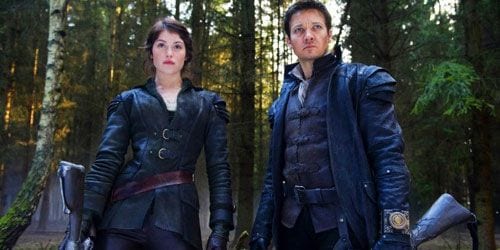
Hollywood’s love affair with Tales from the Public Domain continues with Hansel and Gretel: Witch Hunters, another “reimagining” of a well-known fairy tale. Following the success of Tim Burton’s Alice in Wonderland, studios are treating fairy tales as comic books without pesky rights issues, the perfect subject for the favored cycle of origin, sequel, reboot, repeat.
Hansel and Gretel also belongs to a less auspicious group of would-be blockbusters: it is a January movie, removed from the competitive hustle of summer, Christmas or even early spring, where it was scheduled for release in 2012 before Paramount shunted it off into early 2013. Specifically, Gretel is something like an Underworld movie: a violent, R-rated blending of mythology and gunfire. In this universe, as in the Underworld series, fantastical creatures are often dispatched in the least fantastic method available, unless you count the existence of guns in an unspecified but generally technology-low time period as itself an act of whimsical fantasy.
Still, Hansel and Gretel’s semi-stupid monster-killing methods make a kind of faux-traditional, even historical, sense: the original Brothers Grimm tales feature plenty of splatter, too. It may seem gratuitous when, in the film, witches are decapitated or burned alive, or when a troll smashes human bodies to bits, but no more than the mutilations, cannibalism, and eye-pecking crows of the original texts.
Despite this adherence to the gruesomeness of its source material, Hansel and Gretel aims for a more irreverent, more fractured fairy tale than, say, the stone-faced seriousness of Snow White and the Huntsman. After a Burton-ish prologue retelling the story of children left in the woods by their father and then encountering a witch whom they eventually dispatch, the movie cuts to an adult Hansel (Jeremy Renner) and his sister Gretel (Gemma Arterton), now guns for hire in the witch extermination business. The film’s wannabe-Tarantino bona fides are established as soon as Gretel refers to some angry townspeople as “fucking hillbillies.”
In many versions of the fairly tale, even the younger version of Gretel has a bit more sand than Hansel, who sits in a cage, eating candy the witch supplies to fatten him up; it is Gretel who pushes the witch into the oven. This version makes more of an attempt at equality, casting both brother and sister as proficient killers who might appeal to an 11-year-old boy sneaking into his first R-rated movie. But in a roundabout way, the movie also preserves the female-driven power structure: most of the other women in Hansel and Gretel movies are witches, and to the extent that the siblings are differentiated, Gretel is slightly more feral. Despite being played by the posh-looking Arterton, she’s the one more likely to head-butt or bite her way through problems; Hansel, meanwhile, remains stricken with a folkloric version of diabetes, requiring a needle full of magic insulin every few hours to stay alive.
This may be a good time to explain that not only do Arterton and Renner avoid looking embarrassed while playing adult, mercenary versions of Hansel and Gretel, but they also seem to be enjoying themselves. Arterton often appears to be barely suppressing a smile, and, like so many action heroines before her, she wears her perfectly placed scrapes and cuts like accessories to her stylish leather get-ups. Renner has an offhand, deadpan way of delivering his lines that makes them funnier than they should be; as he bathes in a pond with his mysterious love interest Mina (Pihla Viitala), he mutters about a witch who could breathe underwater and looked like a frog, his distractedness oddly charming.
Those movie-star charm skills are crucial when Hansel and Gretel fails to nail down its flip, wisecracking tone. Its profanities have little rhythm, often isolated in shots that seem like inserts — prep work, maybe, for a TV-appropriate PG-13 cut — and for every clever anachronism (etchings of missing children wrapped around old-timey milk bottles), there are a few that just lay there without comment or wit (the siblings’ cache of automatic weapons).
The movie cries out for more élan, more ingenuity. The story, such as it is, does have a welcome swiftness, the film’s brisk 88-minute running time eliminating any chance of Huntsman-style ponderousness: Hansel and Gretel search for missing children, encounter an evil witch (Famke Janssen), learn some stuff about their past, and fight a bunch of special effects creations. Many of those effects look neat, favoring practical makeup work over the usual CG haze; the troll in particular has a look so tactile it becomes retro (“Trolls are extra,” Hansel notes).
This craft doesn’t particularly elevate Hansel and Gretel: Witch Hunters. It’s like a less screechy Van Helsing or a slightly more whimsical Underworld picture. Even if your brain may reject a movie that doesn’t quite work as thrilling action or cheeky satire, your inner 11-year-old boy may embrace it.

![Call for Papers: All Things Reconsidered [MUSIC] May-August 2024](https://www.popmatters.com/wp-content/uploads/2024/04/all-things-reconsidered-call-music-may-2024-720x380.jpg)



